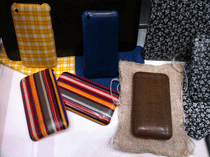Inductive heating tech gaining proponents for automotive interior parts
The model year 2012 passenger car introductions will include vehicles with interior parts made on molds using RocTool's inductive heating technology, as the company sees tremendous growth in automotive. That's newsworthy, but the really interesting bit is in development: the ability to encapsulate essentially any type of 2D material-cotton, linen, silk, photographs and more-between a thin transparent polyamide film and a thermoplastic composite sheet.
April 7, 2011
The model year 2012 passenger car introductions will include vehicles with interior parts made on molds using RocTool's inductive heating technology, as the company sees tremendous growth in automotive. That's newsworthy, but the really interesting bit is in development: the ability to encapsulate essentially any type of 2D material-cotton, linen, silk, photographs and more-between a thin transparent polyamide film and a thermoplastic composite sheet.
|
Should the technology take off, OEMs could then for instance partner with clothing designers to create special product lines; think "Marco Polo automotive interiors" or "Cell phones from Ralph Lauren."
First to the automotive news. This week in Mannheim, Germany, at the German engineering society's (VDI) Plastics in automotive engineering conference, Matt Boulanger, the company's business development manager, told PlasticsToday that his company's inductive heating technology would be used for a number of interior parts fitted into vehicles that will be launched in 2012.
RocTool is the inventor of the CAGE system for inductive heating of molds as well as its 3iTech technology for heating a mold by electromagnetic induction. As explained in our previous articles on RocTool, its technology facilitates rapid heating and cooling of injection molds, which helps prevent warpage and makes for better surface appearance, among other attributes. The company's molds at first were used exclusively for thermoset composites parts, but in the past few years it has very rapidly gained purchase in the thermoplastic molding market.
The company was a first-time exhibitor at last October's K show, where it announced it will offer a license for both the CAGE and 3iTech technologies with purchase of a single license. During our talk in Mannheim this week, Boulanger said the K show was truly a watershed event for the company, with the interest in its technology very high. On stand at the K show in Düsseldorf it was molding a piano-black polycarbonate automotive application using material from Sabic Innovative Plastics, but he said this week that the interior applications now being made or in discussion are both glossy and matte, or even glossy and matt on a single part. The trend is to piano black surfaces, he said.
That's because although the rapid heating and cooling initially was marketed as a great way to get a great finish on parts, and potentially also to cut parts' wall thicknesses, in fact the mechanical properties-things such as weld line strength and even impact strength- also seem to improve. The high-end surface finish means molders and Tier suppliers can reduce their paint use.
Your style, your molding
At the Mannheim event, Boulanger discussed with PlasticsToday the company's ongoing work on molding parts with three-layer structure of a thermoplastic composite bottom and transparent film surface, with fabrics or other materials encapsulated between the two (the photo of the cell phone housings was taken at this event). The thermoplastic composite (for example, PP fibers reinforcing polypropylene) provides a part with support, and the transparent surface film protects the middle layer. Injection molding with RocTool's inductively heated molds is done at very high heat, quickly, with rapid cooling as well, so that the fabric or other center material is not damaged. "Door panels are an obvious application," added Boulanger.
About the Author(s)
You May Also Like



